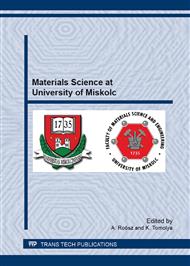p.85
p.95
p.105
p.115
p.125
p.135
p.147
p.157
p.167
Development of a Complex Optimizing Model of Wire Drawing Technology
Abstract:
The drawing of wires with round cross section is a widely used technological method for making a great number of wire products of different range of sizes having excellent material- and surface quality. The planning of any kinds of wire drawing technology is greatly facilitated by knowing the models describing the technological parameters in the best possible way. Mainly the finite element method (FEM) and the analytical method are used for modelling the above parameters. Contrary to FEM, the advantage of the continuous analytical models is that they require less calculation processes and this fact seems to be really a great advantage when planning the technology in industrial circumstances. In the course of planning, the choosing of the individual technological parameters is determined by the cost effectiveness (i.e. the min. specific energy consumption), the quality of products and the productivity. The aim of our research work was to determine and develop a complex optimizing target function for the cold drawing technology which takes into consideration each of the above conditions and hasn’t been published in the references yet. By utilizing the fast computability of analytical model, a design software meeting all the expectations and giving IN-TIME result in industrial circumstances was developed by means of the complex optimization target function
Info:
Periodical:
Pages:
125-134
Citation:
Online since:
March 2013
Authors:
Keywords:
Price:
Сopyright:
© 2013 Trans Tech Publications Ltd. All Rights Reserved
Share:
Citation:


